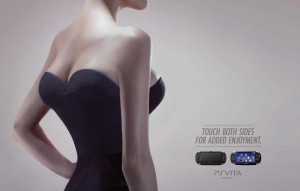Culture Jam Assignment
Shown above is an ad for a handheld gaming device: the PlayStation Vita. Published in approximately 2012, the ad highlights the device’s the double-sided interface – it has a touchpad on the back and a screen on the front. The ad also features a woman with breasts both on her front and her back, with the slogan: “Touch both sides for added enjoyment.”
The negative attitude towards women and feminine bodies in this ad is particularly blatant. Gaming systems have no inherent relationship to sex, yet the graphics and tone of the advertisement are overtly and obnoxiously sexual. The body depicted takes up over half of the ad space; meanwhile, the product itself is relegated to a small corner, attracting much less focus. The ad is sexist because it equates female sexuality with a gaming console – that is, both are depicted as tools for someone else’s enjoyment.
The design of this ad is completely dehumanizing. The lack of a head or face, in addition to the gross distortion of the body, portrays the individual as not an individual at all – they are simply a body. By removing any indicator of an identity, it becomes easier for the consumer to dissociate the body from a human being. Rather, the consumer sees it as an object, to be used for their own pleasure. Indeed, the slogan actively encourages the viewer to do so. The ad depicts a sex toy, not a person with feelings, desires, or even thoughts.
Video games are a product consumed by many during childhood and adolescence, times during which attitudes and morals are being formed and modified. Presenting them with advertisements such as this, particularly at such an impressionable age, reinforces negative attitudes towards female bodies. The ad also reinforces power dynamics between the targeted demographic (i.e. heterosexual males) and women.
This is my version of the ad:
To redesign this ad, I cropped it down to just the corner, including only the slogan and the product itself. I also altered the slogan to read: “Twice the fun.” The new tagline is shorter, catchier, and delivers a similar message as the original ad without also selling women’s bodies as objects.
These changes were intended to highlight the superfluousness of the sexual components, and also bring the actual product being sold into greater focus. The fact that most of the ad could be removed and still get the point across shows that there is no excuse for exploiting women, or any other group, for consumer purposes. Obviously, there are many other effective marketing strategies available.
I chose a simpler selling point; the original ad attempted to use shock value to attract attention. However, the attention came at the expense of women, and with dangerous consequences.
Some people may view this ad and respond cavalierly – “It’s just an ad, it’s just a joke.” However, when people treat small things such as this ad with indifference, it makes room for more serious occurrences – rape, abuse – to be treated with indifference as well. Particularly in contemporary society, advertising is extremely pervasive. Pop culture may be dismissed as trivial, but by definition, it has one of the biggest demographics out of all types of media. Both advertising and pop culture are nearly impossible to avoid – the message will reach its audience, whether they like it or not. Therefore, our responsibility as a society to ensure that the media does not encourage negative attitudes is all the more crucial.

